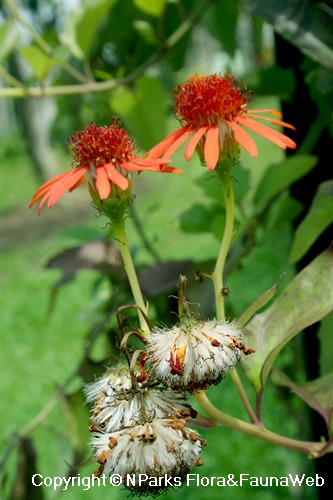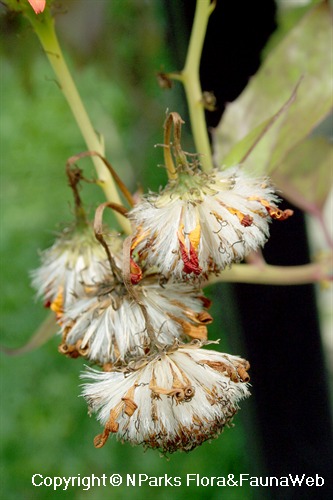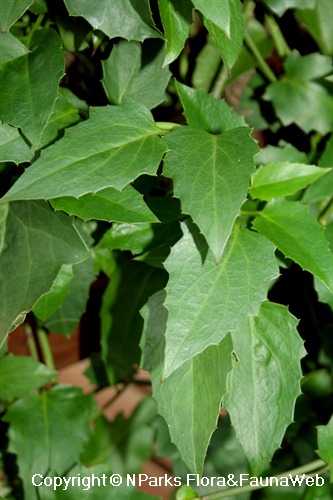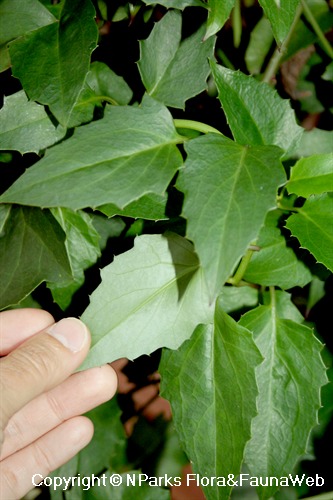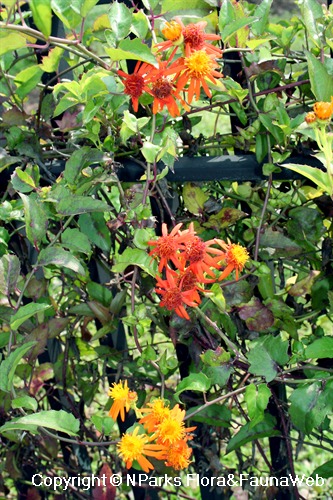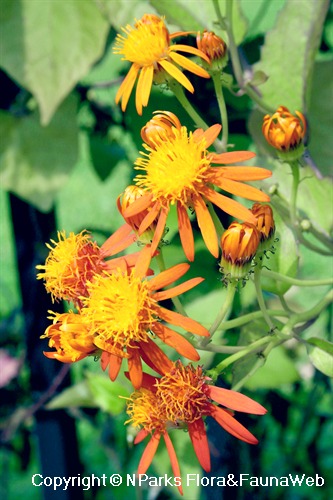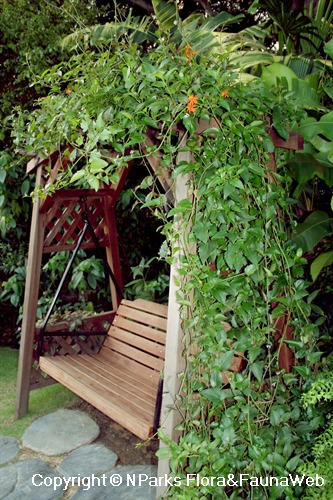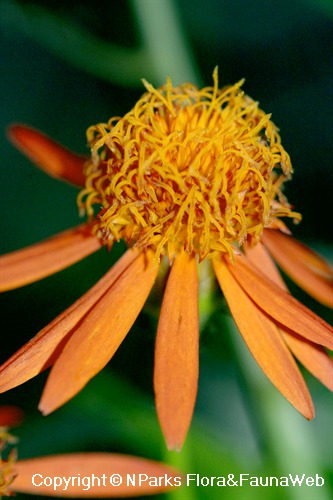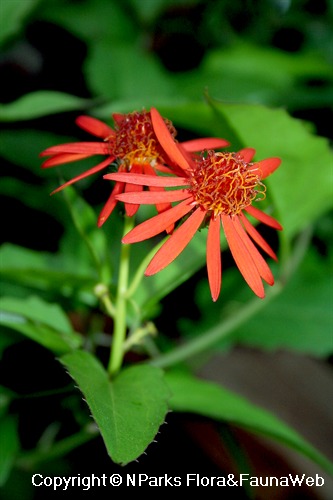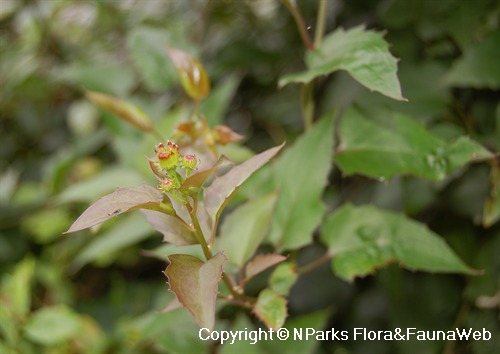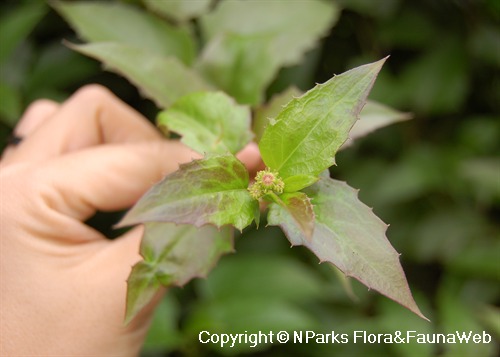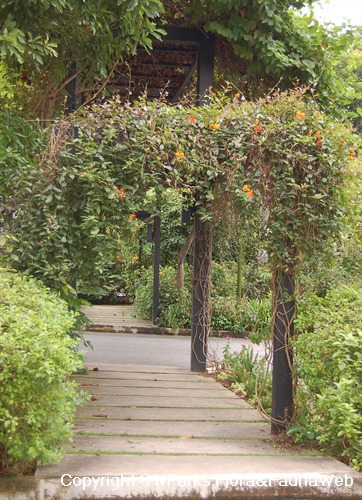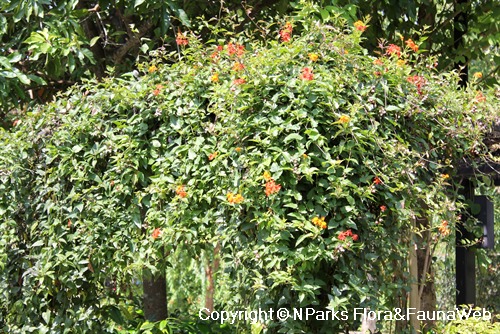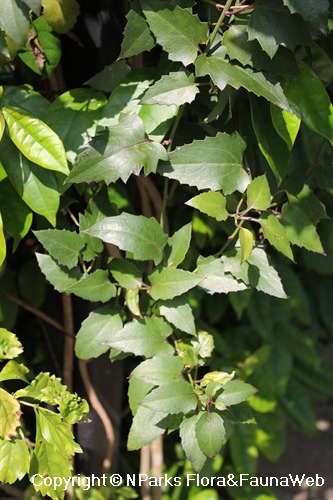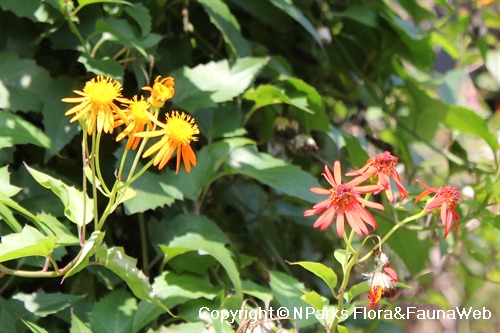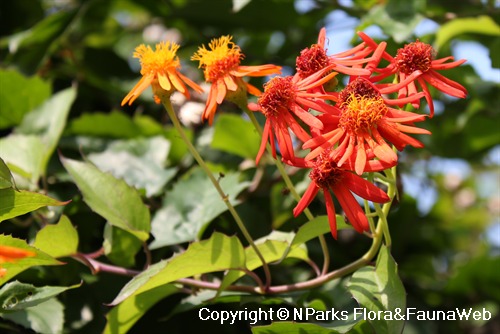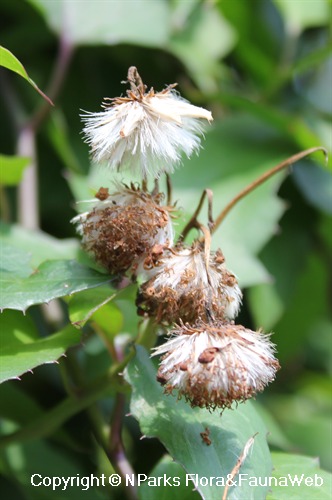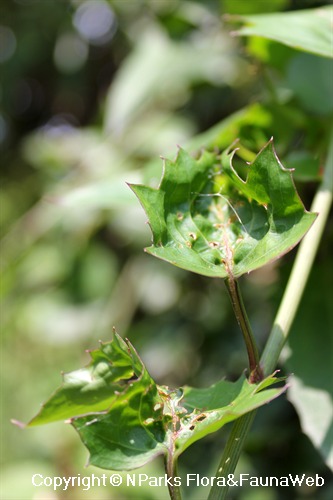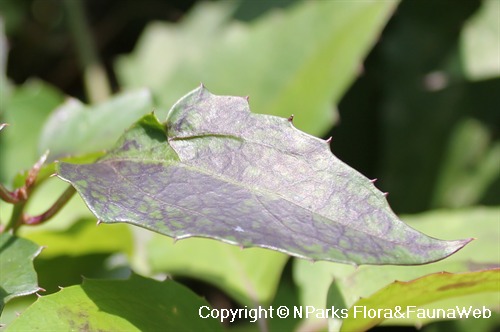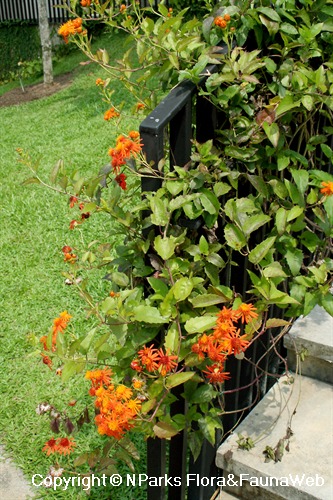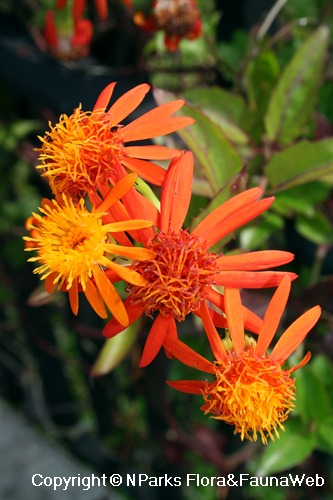
Back
Pseudogynoxys chenopodioides (Kunth) Cabrera
| Family Name: | Asteraceae (Compositae) |
| Synonyms: | Pseudogynoxys berlandieri, Senecio chenopodioides, Acanthospermum berlandieri, Senecio rothschuhianus, Senecio kermesinus, Senecio hoffmannii, Gynoxys cordifolia, Senecio confusus |
| Common Name: | Mexican Flamevine, Orange Glow Vine, Orange-Flowered Groundsel, 火焰藤, 墨西哥火焰, 蔓黃金菊 |
Name
Classifications and Characteristics
| Plant Division | Angiosperms (Flowering Seed Plants) (Dicotyledon) |
|---|---|
| Plant Growth Form | Climber |
| Lifespan (in Singapore) | Perennial |
| Mode of Nutrition | Autotrophic |
| Plant Shape | Irregular |
| Maximum Height | 0.5 m to 6 m |
Biogeography
| Native Distribution | Mexico, Central America, Venezuela, Colombia, Guyana, Suriname |
|---|---|
| Native Habitat | Terrestrial (Disturbed Area / Open Ground) |
| Preferred Climate Zone | Tropical |
Description and Ethnobotany
| Growth Form | Slender twining vine with trailing stems, typically 3m height but may reach 6m with support. Semi-woody, somewhat irregular in form. |
|---|---|
| Foliage | Glossy green, slightly fleshy, elliptically-shaped, with dentate (broadly toothed) margins. |
| Flowers | Produced in small clusters of showy capitulate inflorescences, with central disc florets and petal-like linear ray florets. Florets age from bright orange to reddish-orange when pollinated. Free-blooming, nectar attracts butterflies, bees, day-flying moths (eg. Amata huebneri, syn. Syntomis huebneri) and hummingbirds. |
| Fruit | White and bristly cypselae (2-4mm long), persistent on plant. |
| Habitat | Found in disturbed sites and wastelands in native range. |
| Cultivation | Prefers moist, well-drained soils. Remove spent flower heads periodically to promote blooming all across plant. Unpruned specimens tend to grow leaves and flowers only towards the top. Leaves may display irregular reddish-purple patches or spots in some cases, either due to nutrient deficiency, or attack by Alternaria senedonis fungus which causes leaf lesions. Propagate by seeds, softwood cuttings or air-layering of stems. |
| Etymology | Genus epithet 'Pseudogynoxys' means 'resembling' the Gynoxys genus, another tropical Amercian member of the Asteraceae (daisy) family. (Note: 'Gynoxys' derived from Greek terms of 'gyne' (female) and 'oxys' (sharp or spiny), a reference to the form of the female flower parts of the plant.) Species epithet 'chenopodioides' means 'resembling goosefoot' in Greek (chen: goose, pous: foot), a description of the plant's leaf shape. Plant is used to be known by former name of Senecio confusus, where 'Senecio' is Latin for 'old man' (referring to the white bristly fruits), and 'confusus' means 'uncertain', a probable reference to the irregular trailing habit of the species. |
Landscaping Features
| Desirable Plant Features | Ornamental Foliage, Ornamental Flowers, Fragrant (Flowers) (Day) |
|---|---|
| Landscape Uses | Suitable for Hanging Baskets, Vertical Greenery / Green Wall, Container Planting |
| Thematic Landscaping | Butterfly Garden, Naturalistic Garden |
| Plant & Rootzone Preference or Tolerance Remarks | pH 6.1 - 7.8 |
Fauna, Pollination and Dispersal
| Fauna Pollination Dispersal Associated Fauna | Butterfly-Attracting, Bird-Attracting |
|---|---|
| Pollination Method(s) | Biotic (Fauna) (Insects (Bee), Insects (Butterfly, Moth), Vertebrates (Bird)) |
| Seed or Spore Dispersal | Abiotic |
Plant Care and Propagation
| Light Preference | Full Sun |
|---|---|
| Water Preference | Moderate Water |
| Plant Growth Rate | Moderate |
| Rootzone Tolerance | Fertile Loamy Soils, Well-Drained Soils, Alkaline high pH Soils |
| Maintenance Requirements | Moderate |
| Potential Problems | Leaves may turn reddish-purplish. Could be nutrient deficiency or leaf lesions caused by Alternaria senecionis fungus. |
| Propagation Method | Seed, Stem Cutting, Air-Layering |
Foliar
| Foliage Retention | Evergreen |
|---|---|
| Mature Foliage Colour(s) | Green |
| Mature Foliage Texture(s) | Smooth, Glossy / Shiny |
| Foliar Type | Simple / Unifoliate |
| Foliar Arrangement Along Stem | Alternate |
| Foliar Shape(s) | Non-Palm Foliage (Elliptical) |
| Foliar Venation | Pinnate / Net |
| Foliar Margin | Dentate |
| Foliar Apex - Tip | Acuminate |
| Foliar Base | Rounded / Obtuse, Cuneate, Truncate / Square |
| Typical Foliar Area | Notophyll ( 20.25cm2 - 45 cm2 ) |
Non - Foliar and Storage
| Stem Type & Modification | Woody, Herbaceous |
|---|---|
| Root Type | Underground (Fibrous Root) |
Floral (Angiosperm)
| Flower & Plant Sexuality | Bisexual Flowers |
| Flower Colour(s) | Orange, Red |
|---|---|
| Flower Symmetry | Radial |
| Flower Size - Remarks | 2.5cm diameter |
| Flowering Period | Free-Flowering |
| Flowering Habit | Polycarpic |
| Inflorescence Size Remarks | Flowers age from orange to oramgey-red upon pollination. |
Fruit, Seed and Spore
| Mature Fruit Colour(s) | Black, White |
|---|---|
| Fruit Classification | Simple Fruit |
| Fruit Type | Indehiscent Dry Fruit , Cypsela |
Image Repository
Others
| Master ID | 29165 |
|---|---|
| Species ID | 3474 |
| Flora Disclaimer | The information in this website has been compiled from reliable sources, such as reference works on medicinal plants. It is not a substitute for medical advice or treatment and NParks does not purport to provide any medical advice. Readers should always consult his/her physician before using or consuming a plant for medicinal purposes. |

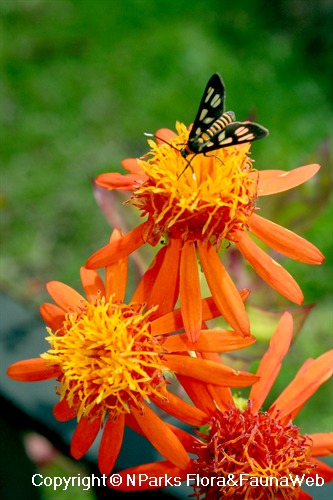
.jpg)
